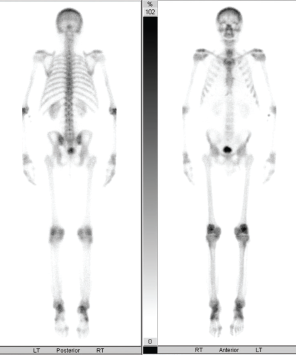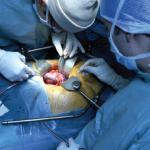
Figure 4: Bone Scan
The bone scan showed increased bilateral symmetric uptake in the patient’s knees and ankles.
The exact pathogenesis of CIPS is not clearly defined. However, CNIs cause increased vascular changes that disrupt bone perfusion and permeability. This leads to intraosseous vasoconstriction and bone marrow edema, which causes pain. It is also postulated that CNI use results in facilitation of pro-nociceptive processes by interrupting glial function and by inhibition of nuclear factor-activated T cells.14
Calcineurin regulates two-pore-domain potassium channels (K2Ps), which influence neuronal excitability and maintain resting membrane potentials, serving an important role in nociceptive regulation. The inhibition of calcineurin removes the regulation of these K2Ps, leading to enhanced neuronal excitability.14
The most effective treatment of CIPS is modification of the immunosuppressive regimen, either with the use of a non-calcineurin agent or with close monitoring of CNI levels and adjustment of the dose (as was done in this patient).2 Extremity elevation is also advised.2
Therapy adjuncts include calcium channel blockers, such as nifedipine; GABA analogs, such as pregabalin; and bisphosphonates, such as IV pamidronate.3,15 Controversy exists regarding the usefulness of adjunctive therapies, although improvement in patient-reported symptoms have been observed in several case reports and series. CIPS is usually completely reversible over a period of months, without long-term sequelae.
With a steady increase in the number of recipients of organ and hematopoietic stem cell transplants and, hence, more prevalent CNI use, this otherwise uncommon diagnosis is important to recognize. If identified early, cessation of CNIs in favor of an alternate immunosuppressive agent (or modification of the dose of CNI) is recommended, and musculoskeletal symptoms often quickly abate.
Priyanka Iyer, MD, MPH, is a second-year fellow in adult rheumatology at the University of Iowa, Iowa City.
Acknowledgment
The author would like to extend special thanks to Brittany Bettendorf, MD, who was an integral part of the treatment team and helped establish a unifying diagnosis.
References
- Adwan MH. An update on drug-induced arthritis. Rheumatol Int. 2016 Aug;36(8):1089–1097.
- Grotz WH, Breitenfeldt MK, Braune SW, et al. Calcineurin-inhibitor induced pain syndrome (CIPS): A severe disabling complication after organ transplantation. Transpl Int. 2001;14(1):16–23.
- Elder GJ. From marrow oedema to osteonecrosis: Common paths in the development of post-transplant bone pain. Nephrology (Carlton). 2006 Dec;11(6):560–567.
- Lucas VP, Ponge TD, Plougastel-Lucas ML, et al. Musculoskeletal pain in renal-transplant recipients. N Engl J Med. 1991 Nov 14;325(20):1449–1450.
- Stevens JM, Hilson AJ, Sweny P. Post-renal transplant distal limb bone pain. An under-recognized complication of transplantation distinct from avascular necrosis of bone? Transplantation. 1995 Aug 15;60(3):305–307.
- Lawson CA, Fraser A, Veale DJ, Emery P. Cyclosporin treatment in psoriatic arthritis: A cause of severe leg pain. Ann Rheum Dis. 2003 May;62(5):489.
- Maeshima K, Ishii K, Horita M, et al. [Calcineurin-inhibitor induced pain syndrome (CIPS) in an adult-onset Still’s disease patient]. Nihon Naika Gakkai Zasshi. 2008 Nov 10;97(11):2782–2784.
- Isaacs KL. Severe bone pain as an adverse effect of cyclosporin therapy for Crohn’s disease. Inflamm Bowel Dis. 1998 May;4(2):95–97.
- Rahman AH, O’Brien C, Patchett SE. Leg bone pain syndrome in a patient with ulcerative colitis treated with cyclosporin. Ir J Med Sci. 2007 Jul–Sep;176(2):129–131.
- Tillmann FP, Jager M, Blondin D, et al. Post-transplant distal limb syndrome: Clinical diagnosis and long-term outcome in 37 renal transplant recipients. Transpl Int. 2008 Jun;21(6):547–553.
- Collini A, De Bartolomeis C, Barni R, et al. Calcineurin-inhibitor induced pain syndrome after organ transplantation. Kidney Int. 2006 Oct;70(7):1367–1370.
- Villaverde V, Cantalejo M, Balsa A, Mola EM. Leg bone pain syndrome in a kidney transplant patient treated with tacrolimus (FK506). Ann Rheum Dis. 1999 Oct;58(10):653–654.
- Bouteiller G, Lloveras JJ, Condouret J, et al. [Painful polyarticular syndrome probably induced by cyclosporin in three patients with a kidney transplant and one with a heart transplant]. Rev Rhum Mal Osteoartic. 1989 Nov;56(11):753–755.
- Smith HS. Calcineurin as a nociceptor modulator. Pain Physician. 2009 Jul–Aug;12(4):E309–E318.
- Gauthier VJ, Barbosa LM. Bone pain in transplant recipients responsive to calcium channel blockers. Ann Intern Med. 1994 Dec 1;121(11):863–865.

